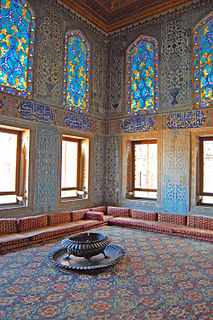 W
WHarem properly refers to domestic spaces that are reserved for the women of the house in a Muslim family. A harem may house a man's wife or wives, their pre-pubescent male children, unmarried daughters, female domestic servants, and other unmarried female relatives. In harems of the past, concubines, which were enslaved women, were also housed in the harem. In former times some harems were guarded by eunuchs who were allowed inside. The structure of the harem and the extent of monogamy or polygamy has varied depending on the family's personalities, socio-economic status, and local customs. Similar institutions have been common in other Mediterranean and Middle Eastern civilizations, especially among royal and upper-class families, and the term is sometimes used in other contexts. In traditional Persian residential architecture the women's quarters were known as andaruni, and in the Indian subcontinent as zenana.
 W
WThe harem of the caliphs of the Abbasid Caliphate (750–1258) in Baghdad was composed of his mother, wives, slave concubines, female relatives and slave servants, occupying a secluded portion of the Abbasid household. This institution played an important social function within the Abbasid court and was the part of court were the women of the court were confined and secluded. The senior woman in rank in the harem was the mother of the Caliph. The Abbasid harem acted as a role model for the harems of other Islamic dynasties, as it was during the Abbasid Caliphate that the harem system was fully enforced in the Muslim world.
 W
WHarem properly refers to domestic spaces that are reserved for the women of the house in a Muslim family. A harem may house a man's wife or wives, their pre-pubescent male children, unmarried daughters, female domestic servants, and other unmarried female relatives. In harems of the past, concubines, which were enslaved women, were also housed in the harem. In former times some harems were guarded by eunuchs who were allowed inside. The structure of the harem and the extent of monogamy or polygamy has varied depending on the family's personalities, socio-economic status, and local customs. Similar institutions have been common in other Mediterranean and Middle Eastern civilizations, especially among royal and upper-class families, and the term is sometimes used in other contexts. In traditional Persian residential architecture the women's quarters were known as andaruni, and in the Indian subcontinent as zenana.
 W
WThe harem conspiracy was a plot to murder the Egyptian pharaoh Ramesses III. The principal figure behind the plot was one of the pharaoh's secondary wives, Tiye, who hoped to put her son Pentawer on the throne instead of the pharaoh's chosen successor, Ramesses IV. The plan was organized by the court official Pebekkamen. The plot succeeded in causing the death of the pharaoh, but failed to establish Pentawer on the throne. In the aftermath, the leading conspirators were convicted and executed.
 W
WThe Harem Years (ISBN 978-0935312706) is a firsthand account of the private world of a harem in colonial Cairo.
 W
WThe Imperial Harem of the Ottoman Empire was the Ottoman sultan's harem – composed of the wives, servants, female relatives and the sultan's concubines – occupying a secluded portion (seraglio) of the Ottoman imperial household. This institution played an important social function within the Ottoman court, and wielded considerable political authority in Ottoman affairs, especially during the long period known as the Sultanate of Women. Multiple historians claim that the sultan was frequently lobbied by harem members of different ethnic or religious backgrounds to influence the geography of the Ottoman wars of conquest. The utmost authority in the Imperial Harem, the valide sultan, ruled over the other women in the household; the consorts of the sultan were normally of slave origin, and thus were also his mother, the valide sultan.
 W
WA seraglio or serail is the sequestered living quarters used by wives and concubines in an Ottoman household. The term harem is a generic term for domestic spaces reserved for women in a Muslim family, which can also refer to the women themselves. The Ottoman Imperial Harem was known in Ottoman Turkish as Harem-i Hümâyûn.
 W
WHarem properly refers to domestic spaces that are reserved for the women of the house in a Muslim family. A harem may house a man's wife or wives, their pre-pubescent male children, unmarried daughters, female domestic servants, and other unmarried female relatives. In harems of the past, concubines, which were enslaved women, were also housed in the harem. In former times some harems were guarded by eunuchs who were allowed inside. The structure of the harem and the extent of monogamy or polygamy has varied depending on the family's personalities, socio-economic status, and local customs. Similar institutions have been common in other Mediterranean and Middle Eastern civilizations, especially among royal and upper-class families, and the term is sometimes used in other contexts. In traditional Persian residential architecture the women's quarters were known as andaruni, and in the Indian subcontinent as zenana.